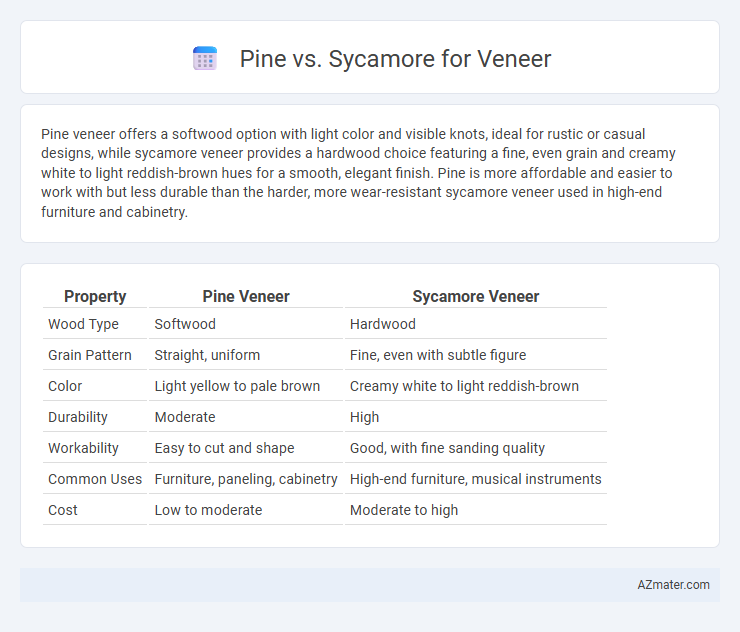Pine veneer offers a softwood option with light color and visible knots, ideal for rustic or casual designs, while sycamore veneer provides a hardwood choice featuring a fine, even grain and creamy white to light reddish-brown hues for a smooth, elegant finish. Pine is more affordable and easier to work with but less durable than the harder, more wear-resistant sycamore veneer used in high-end furniture and cabinetry.
Table of Comparison
| Property | Pine Veneer | Sycamore Veneer |
|---|---|---|
| Wood Type | Softwood | Hardwood |
| Grain Pattern | Straight, uniform | Fine, even with subtle figure |
| Color | Light yellow to pale brown | Creamy white to light reddish-brown |
| Durability | Moderate | High |
| Workability | Easy to cut and shape | Good, with fine sanding quality |
| Common Uses | Furniture, paneling, cabinetry | High-end furniture, musical instruments |
| Cost | Low to moderate | Moderate to high |
Introduction to Pine and Sycamore Veneer
Pine veneer is renowned for its warm, light-colored tones and distinctive grain patterns, making it a popular choice for rustic and traditional furniture designs. Sycamore veneer, characterized by its pale cream color and subtle, intricate figuring, offers a smooth, sophisticated aesthetic suited for modern and refined interiors. Both veneers provide versatile options in woodworking but differ significantly in hardness, texture, and overall visual appeal.
Botanical Overview of Pine and Sycamore
Pine (genus Pinus) is a coniferous evergreen tree characterized by needle-like leaves and resin-rich wood, commonly used for veneer due to its straight grain and light color variations. Sycamore (genus Platanus) is a deciduous hardwood tree recognized for its broad leaves and distinctive mottled bark, producing veneer prized for its fine texture and interlocking grain patterns. Botanical differences influence veneer applications, with pine's softness ideal for rustic aesthetics and sycamore's hardness providing durability and detailed woodworking finishes.
Appearance and Grain Patterns
Pine veneer showcases a light, warm tone with distinct knots and a straight to slightly wavy grain pattern, imparting a rustic and natural aesthetic ideal for casual or country-style interiors. Sycamore veneer features a creamy to pale brown color, often highlighted by subtle ripple or birdseye patterns, offering a smooth and elegant appearance suited for refined and contemporary designs. The pronounced grain texture of pine contrasts with sycamore's smoother and more uniform grain, making each wood type uniquely appealing for specific decorative applications.
Workability and Machining
Pine veneer offers exceptional workability due to its soft texture, allowing for easy cutting, shaping, and sanding, making it ideal for intricate designs and detailed woodworking. Sycamore veneer, while harder than pine, provides a smoother, more consistent surface that enhances machining precision and reduces tool wear, beneficial for high-volume or automated processes. Both woods respond well to adhesives and finishes, but pine's lower density often results in faster production times compared to the denser sycamore.
Durability and Longevity
Sycamore veneer offers superior durability compared to pine, with a harder surface that resists dents and scratches, making it ideal for high-traffic or frequently used furniture. Pine veneer, while more affordable and easier to work with, is softer and more prone to wear and damage over time. For long-lasting applications, sycamore provides enhanced longevity due to its dense grain structure and resistance to moisture and decay.
Cost Comparison
Pine veneer is generally more affordable than sycamore due to the faster growth rate and wider availability of pine trees, making it a cost-effective choice for budget-sensitive projects. Sycamore veneer, prized for its distinctive grain patterns and higher durability, typically commands a higher price reflecting its premium quality and slower harvest cycles. When comparing costs, pine veneer offers economical benefits without sacrificing basic aesthetic appeal, while sycamore veneer presents a higher upfront investment justified by its unique look and longevity.
Environmental Impact and Sustainability
Pine veneer is generally considered more sustainable due to faster growth rates and higher carbon sequestration compared to sycamore, which grows slower and requires more resources. Pine forests often benefit from sustainable forestry practices, including replanting and shorter rotation periods, reducing environmental impact. Sycamore veneer, while durable, may contribute to greater habitat disruption and higher water usage during cultivation, affecting its overall sustainability profile.
Common Applications in Veneering
Pine veneer, valued for its light color and distinct grain pattern, is commonly used in furniture making, cabinetry, and decorative paneling to achieve a rustic or country-style aesthetic. Sycamore veneer, characterized by its subtle, wavy grain and pale cream tone, is frequently applied in high-end furniture, musical instruments, and architectural millwork for a fine, elegant finish. Both veneers offer versatility, but pine suits casual, warm interior designs while sycamore fits sophisticated, contemporary applications requiring smooth texture.
Pros and Cons of Pine vs Sycamore Veneer
Pine veneer offers a warm, rustic appearance with distinct grain patterns, making it ideal for casual and country-style interiors, but its softness makes it prone to dents and scratches. Sycamore veneer presents a smoother, more uniform grain with a lighter color, providing a modern, clean look and greater durability, yet it can be more expensive and may show stains more easily. Choosing between pine and sycamore veneers depends on the balance between desired aesthetics, surface hardness, and maintenance considerations.
Choosing the Right Veneer for Your Project
Pine veneer offers a warm, rustic appearance with a soft texture ideal for cozy, natural-looking interiors, while sycamore veneer provides a more uniform grain and light, creamy color suitable for modern, sleek designs. Pine is easier to work with and cost-effective, making it a practical choice for budget-friendly projects, whereas sycamore's durability and fine grain pattern enhance more high-end or decorative applications. Selecting between pine and sycamore veneers depends on the desired aesthetic, project budget, and the level of wood hardness required for long-lasting performance.

Infographic: Pine vs Sycamore for Veneer
 azmater.com
azmater.com